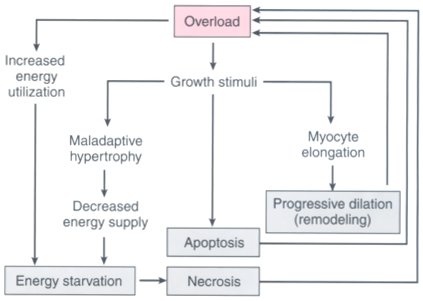Figure 50-44
Some of the vicious cycles that operate in an overloaded
heart. Overload both increases energy utilization and stimulates growth (dark
arrows). The former contributes directly to a state of energy starvation,
which is made worse by several consequences of maladaptive hypertrophy that decrease
the energy supply. The latter includes myocyte elongation, which causes remodeling,
a progressive dilatation that increases wall tension and thereby increases the overload.
Growth stimuli also promote apoptosis, which by decreasing the number of viable
cardiac myocytes, increases the load on those that survive. Hypertrophy also causes
architectural changes that reduce the energy supply to working cardiac myocytes.
(Redrawn from Katz LN: Maladaptive hypertrophy and the cardiomyopathy of
overload: Familial cardiomyopathies. In Katz AM
[ed]: Heart Failure: Pathophysiology, Molecular Biology, and Clinical Management.
Philadelphia, Lippincott Williams & Wilkins, 2000, pp 277–307.)

